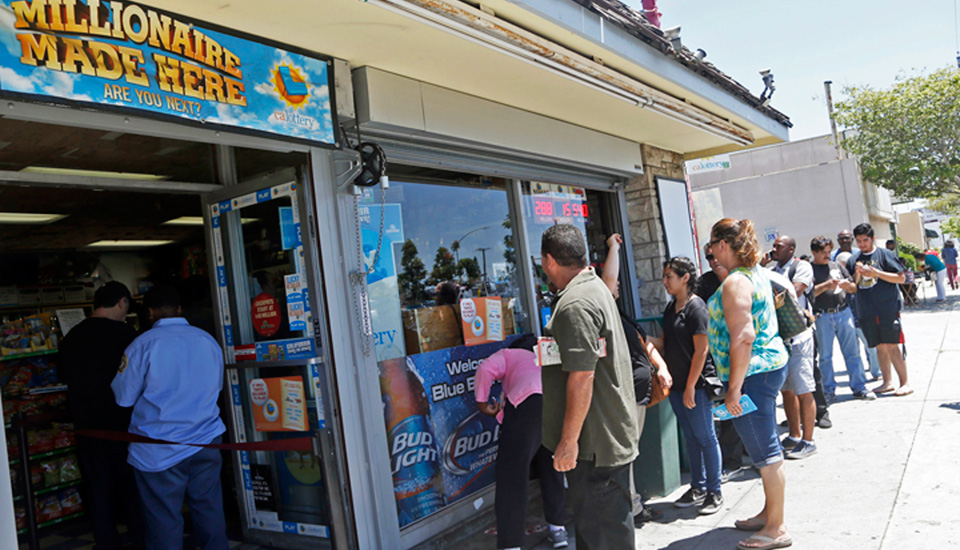
Nearly the entire country is eligible to win the $162 million in the upcoming Mega Millions drawing. Local news is busy rerunning its typical lottery stories. Long lines of people smiling and eager to spend. Asking the typical questions, what will you do with the winnings? Will you still work? What are your magic numbers? Conversations with the convenience store owner, who faithfully describes how “crazy” the business is. Maybe even Good Morning America will have a segment on it.
I suppose I might play, too. What’s a dollar or two for the possibility of going on vacation like never before, helping out friends and family, and enjoying early retirement? (Without the lottery, I probably have little chance of ever retiring.) When looked at on the individual, short-term level, the lottery is harmless and great daydream material. However, if we step back, take our time, and analyze it, a much more damaging picture emerges.
Widespread and lucrative
Today, 44 states have heavily advertised lotteries, which is why they are the most widespread form of legal (and maybe all) gambling.
Comedian John Oliver quips that sales from lottery tickets are greater than sales from movie tickets, music, pornography, the NFL, MLB, and video games combined. And state lotteries have enormous profit rates.
During colonial America, various (mostly unsuccessful) lotteries helped fund infrastructure and church construction. By the 1870s, most gambling, including lotteries, was outlawed, ended by a combination of a Louisiana lottery bribery scandal and new federal laws.
The mob-controlled numbers game endured in the cities, but the state-run legal lottery comeback only started in 1964 in New Hampshire. Two years later, New York entered the fray, and in 1970, neighboring New Jersey. Five years later, 10 more states offered them. Since the rebirth, no state has abolished its lottery.
Money for education with the “lottery tax”
To win approval for lotteries, states always proclaim that proceeds will benefit the public good, usually public education. In some states, lottery funding accounts for more than five percent of all education funding.
But the evidence is in: lotteries do not increase education spending. Oliver mentions a study of 24 lottery states in which 21 of them kept flat or decreased education spending. North Carolina calls its lottery the “North Carolina Education Lottery.” However, by July 2014, the state spent less (when adjusted for inflation) on education than was the case before the lottery began (2005). Though the Virginia lottery began in 1988, it wasn’t until 1995 that lottery earnings were earmarked for education. In one examination by Money magazine, states with lotteries spent a lower portion of their total budget on education than did states without lotteries.
For state governments, lotteries generate revenue without taxation. This key feature leads one critic to predict that “given the budget crises facing many local governments today and the current tax-increase antipathy, it is hard to imagine that our lottery states will abandon” the games. In reality though, lotteries are an indirect, nearly hidden tax.
And as revenue tools, they are very regressive. More than half of adults buy lottery tickets at some point, but the overwhelming majority of tickets are bought by approximately 20 percent of the population, typically the poorer and less educated. (For example, Wired magazine refers to a 2006 survey in which 30 percent of respondents without high school degrees said playing the lottery was a wealth-building strategy.) Like other regressive taxes, lotteries especially hit African Americans and Latinos, who buy disproportionately more lottery tickets than do white people.
The constant drive to expand
The typical pattern is as follows: (1) A neighboring state has a lottery. (2) Your state decides to set up its own rather than see residents drive over the border to play. (3) At first, the lottery is small, but soon the number of games and jackpots expand. (4) Neighboring states must up the ante to match the competition.
Video lottery terminals might be the most successful method of expansion. In Oregon, greater than 85 percent of lottery revenue comes from them. Selling tickets at convenience stores has made the games extremely accessible, but now players can buy through mobile devices – no need to go out.
Instant games offering much lower payouts but also better (though still poor) odds of winning have helped the states, too. Indeed, lotteries with daily numbers in the afternoon and evening have significantly cut into the illegal numbers game: though the payout is slightly lower, the state never fails to pay the winner, unlike the numbers holes.
Multi-state games with winnings into the hundreds of millions of also boost sales. Powerball and Mega Millions each operate jointly in nearly every lottery state plus Washington, D.C. and some U.S. territories, and there are seven other joint state lotteries, a number seemingly bound to increase.
Allowing winners to take their money all at once instead of receiving payments over time has also helped sales. I have heard from countless coworkers how they can invest the winnings and do better than the state. (None of them have won, so their claim is unproven.) But beware: winning all of the money at once enables you to lose it nearly all at once. Estimates of how many big winners quickly go bankrupt vary from around 30 percent to as high as 70 percent.
Marketing, advertising, deception
When revenues level off, lotteries increase their advertising, which had been banned by the federal government until 1975. Because lotteries are state entities, they are exempted from the Federal Trade Commission’s truth-in-advertising standards. This is unfortunate, because a little more regulation could go a long way.
At its worst, one state lottery (Ohio) targeted the extra poor: The advertising plan for its marquee game called for lottery promotions to coincide with the receipt of government benefits, payroll, and Social Security payments.
On a less repulsive level, this advertising seems to be built upon three principles. Encourage “magical thinking,” maintain strong purchasing by heavy users, and encourage increased or new purchasing by light or non-users. Instant games used to “sell themselves,” but they, too, are now marketed and are usually redesigned using “extended play” games that unnecessarily stretch out. Needing to scratch off all those boxes might seem to make the games more fun and more likely to be winners, but they are there to hook more people into losing more money.
The idea sold is that the winners are random, but scratch-off tickets have anything but random winners. As the Wired article reasoned, “The tickets are clearly mass-produced, which means there must be some computer program that lays down the numbers. Of course, it would be really nice if the computer could just spit out random digits. But that’s not possible, since the lottery corporation needs to control the number of winning tickets. The game can’t be truly random. Instead, it has to generate the illusion of randomness while actually being carefully determined.”
In absolute terms, lotteries promise the greatest payouts compared to other gambling. And they are, but also true is the fact that the percentage of revenues that are returned as prizes is less than that for horse race betting. That is to say, the house (the state) keeps a massive amount. The odds are downplayed (and not mentioned, except on the backs of the betting slips). It is preposterous that lottery ads are allowed to say “anything can happen” when the odds of anything happening are millions (or more) to one.
Despite the horrible odds…
With such horrible odds, why do people continue to play? For the occasional player, it is easy to answer: what is the harm to sacrifice the price of a candy bar or two for a chance to become a millionaire? For heavy players, it is also easy to answer: addiction and hope. Addiction to gambling has become such a problem, most states have been pressured into at least ostensibly working on it. Hope is another way to justify such ridiculous odds.
There are only a few companies – Scientific Games, Gtech Printing, and Pollard Banknote among them – that produce the majority of tickets for the U.S. and Canada. Since these companies “oversee much of the development, algorithm design, and production of the different gambling games,” state lotteries are dependent upon them. The companies, in turn, constantly lobby the states for the continuation and expansion of games and donate heavily to state political campaigns.
Progressive state legislators must oppose efforts to increase advertising funding for their respective lotteries. When confronted with the depletion of the regular education funding, they should not go along with proposals to supplant or “increase” it with lottery revenue. In the long-term, when our country someday has genuine people’s governments (at the state and federal level), sharper decisions must be made. In all cases, restricting the games will be profoundly unpopular, now that we have a fifty-year-long tradition of lottery.
So go ahead and play the Mega Millions. I might. But remember a few points. In Montana, “Winners Happen,” but only because many more people must lose. In Georgia, “Today Could Be the Day,” but it probably won’t be. In New York, “Hey, You Never Know”, but if you look at the odds, you can make a decent prediction. And in Ohio, “Take a Chance on Education. Odds are, you’ll have fun!” But also remember, the lottery rarely adds money to the education budget, and ask yourself how fun it is to lose.










